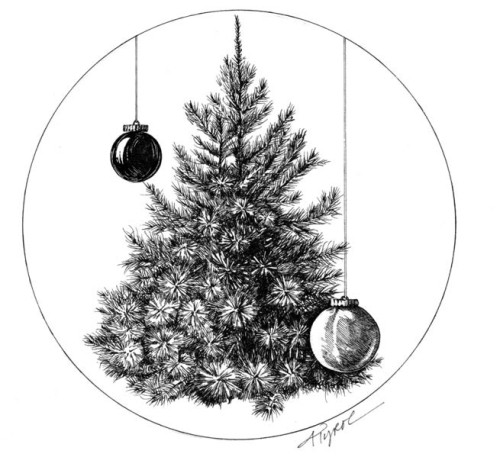
There are few symbols of the holiday season more universally recognized than the Christmas tree. Selecting it, chopping it down, trimming it, and placing on the star are traditions anticipated year after year by those celebrating the season. There are songs to sing around the Christmas tree and parties to celebrate its decoration. There are December nights spent around it awash in its glow, and January days spent wondering when someone else will take it down.
Ask any young child to draw a Christmas tree and chances are he’ll draw something close to a triangle. If the kid is particularly talented, she’ll draw a cone. Indeed, the cone-shaped tree is as traditional as the holiday itself. Sure, there are Charlie Browns among us who will settle for a less-than-perfect Christmas tree. But most of us look for a fir or spruce with just the right taper, symmetry, and conical form.
That conical shape is certainly the norm at most Christmas tree farms, and the short explanation for it is that the tree farmer shears the trees to look that way. But even if you’re wandering afield in search of a wild Christmas tree, far from any shears or knives, you’ll still find plenty of classic cone-shaped specimens out there. In winter, these conical evergreens stand out against the more rounded and leafless birches, beech, and maple.
Why is your Christmas tree conical (though your spouse might say comical)? Like so many of nature’s designs, trees – including spruce and fir – take shape according to a system. Their branches don’t grow randomly in various directions. Rather, there’s an intriguing pattern to this story. It’s a story of dominance and control – not exactly traditional holiday themes, I’ll grant you, but a good story nevertheless.
Look at your Christmas tree. At its top is one vertical shoot that should be longer than all the other shoots around it. This shoot is called the leader, and it exerts control over all the shoots below it. This mechanism has evolved, presumably, to ensure that the tree’s main thrust is upward toward its source of energy, the sun. That it makes an excellent stem upon which to place a star is just a bonus.
Almost all trees begin their life this way. However, while a cone shape is retained in conifers, it is soon lost in most hardwoods as the tree grows and the single, central stem gives way to lateral branches that often grow at least as fast as the leader.
In spruce and fir, the leader outgrows the lateral branches below it, resulting in a conical and a well-defined central trunk. The leader exercises its dominance with help from a hormone called auxin in the top bud, which inhibits the elongation of the shoots below it. They still grow, but not as fast as the leader. The pattern goes like this: in any given year, increases in length are greatest at the top of the tree, and these increases diminish downward and inward toward the bottom. The reason the lower branches are longer is that they are older. They’ve had more years to add growth. But in any given year, they don’t grow as much as the upper branches. Thus, the tree takes a conical form and maintains it indefinitely.
Or at least until the leader’s dominance is interrupted.
This occurs, for example, if an insect destroys the bud at the top of the leader. In such cases, the lateral shoots just below the leader – newly freed from its control – resume growth at their full potential, vying to outpace each other in a race for dominance. The fastest growing of them becomes the new leader, and dispatches its hormones to suppress the others. The result is a crooked stem, as seen in so many white pines whose leaders have been killed by the white pine weevil.
There is an interesting irony to this story of conics, though. Although the dominant-leader phenomenon results in the conical shape sought after in Christmas trees, Christmas tree growers actually try to overcome it by shearing. Without shearing, the tree does take on a nice conical shape, but an unsheared tree is very open. That is, it tends to be airy and not very dense. Shearing, on the other hand, stimulates the opening of many buds lying dormant along the branches, and encourages the shoots within them to elongate. This results in a fuller, denser tree.
May all your Christmas trees be just the way you want them.


Discussion *